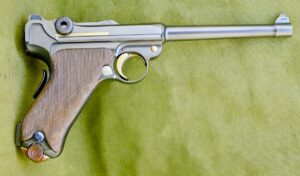
By Jim Dickson | Contributing Editor
While some collectors decry any touching of the original finish of antique guns the fact remains that a gun in poor condition has a much less chance of being preserved.
The general public’s attitude has changed on this and the emphasis is on guns in good condition. If you want Grandpa’s gun or your treasured war trophy to be cherished and preserved by your heirs, you had better take a hard look at its condition. Museums offer a good example of this. The fancy arms of kings and nobles are lovingly cared for and carefully showcased but the battered relics that actually came out of history’s battles are held in low regard by most museum curators. They want the pretty shiny stuff to put on display. As for the more mundane issue guns, well, just look at the rare Nordenfelt multi-barrel machinegun outside at the Tower of London or the 1 inch Gatling gun rusting outside in the salt air in the battery at Charleston, South Carolina. Museums have often scrapped rare guns that they no longer wanted to exhibit.
Families are also often poor conservators of treasured firearms. I know of one family who accidentally sold their Grandfather’s favorite pistol and another that unwittingly sold their Father’s favorite pistol. It’s not uncommon for “All those old guns” to be sold off to a dealer for a ridiculously low price instead of being treasured as family heirlooms as previous generations did. A gun in new condition has a lot better chance of standing out and being kept.
Restoration to new condition offers the best hope of preservation for any firearm in poor shape. I am not talking about a simple reblue job. I am talking about putting the gun back in new condition inside and out. This is fairly rare and most people are not aware that it is possible or where it can be done. One of the best places to get this work is the shop of Eugene Golubstov, AKA Lugerman because of his fame in making duplicates of the U.S. Army 1907 Test Trials Luger pistol to original DWM standards.
If the old gun doesn’t work reliably Eugene will make it reliable. He is a first class troubleshooter of firearms. I have seen factories shelve designs that they could not make work when a talented troubleshooter like Eugene could have made the gun a success. It is worth remembering that when General Thompson was assembling his team to design and make the famed Thompson Submachinegun he hired Charles Tunks, a good “Gun tinkerer” to work the bugs out of the new design.
Sometimes a treasured firearm is recovered after a fire. As long as the metal itself is not burned, that is heated past welding heat so that it sends out sparks as the carbon in the steel burns out, Eugene can re-heat treat it and restore it to new.
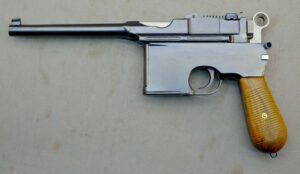
Barrels are replaced or relined with a stepped liner silver soldered in place. If a gun like a Broomhandle Mauser pistol has a bulged or split barrel from firing with an obstructed bore so that it cannot be relined, he will cut the barrel off in front of the elaborately machined rear section and install a new barrel in it there.
Most Mauser Military pistols imported in recent years saw long hard service in China and the far East and are badly in need of restoration. Eugene has brought a lot of these back to new condition and that is a very good thing for the M1896 Mauser pistol is an incredibly effective weapon. While it feels clumsy in the hand it is amazingly accurate and when coupled with the now legal shoulder stock it becomes the steadiest firearm of its size ever made. Just grab the front of the magazine well for a fore end and it locks in place rock steady for precision shooting. The photo shows a typical battered worn out Mauser broomhandle that Eugene has restored to new condition inside and out.
Many guns have deep gouges, pits, and reblued guns have lost their sharp edges to the buffing wheel. I well remember one of the finest Best Quality shotguns to ever come from the British Isles ruined by the buffing wheel when some clod got a cheap reblue job on it. Eugene uses a TIG welder to build the lost metal back up and then it is filed down by hand and hand polished so there is no buffing wheel to round any corners or sharp edges off. All markings are photographed and carefully re-engraved so they are indistinguishable from their original condition. An original finish can be applied or a presentation rust blue done as a final step. Whatever the customer desires. If you are going to spend the money to go this far I would go whole hog and go for the finest polished rust blued finish for a real knock-out presentation type piece.
The finished gun will be test fired and reliable functioning insured. Eugene does not let unreliable guns leave his shop. He knows that any gun at some point may be called upon to defend its owner’s life with the deadly force it was designed to deliver no matter how pretty it looks now.
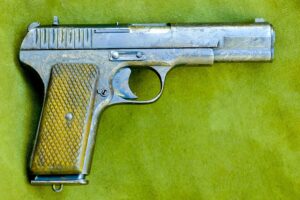
The Tokarev pistol shown in the photos is a good example of an extreme restoration job. It is a 1944 Izhevsk production gun. The factory marking is between the year and the serial number and for Izhevsk it is a round circle with a triangle inside and inside the triangle there is an arrow pointing up.
This battlefield pick-up gun was deeply scarred in the pattern seen on guns that have been run over by a tank and damaged by the tank tracks. It was pitted in the pattern usually seen from blood being left on it. Whoever recovered it simply stuffed it in a holster without cleaning it at the time. That’s just the way it is when a battle is underway. This gun had real character if you knew what you were looking at but to most people it looked like the worst example of a pistol possible.
This pathetic looking piece was detail stripped and soaked in a gentle acid solution and then sandblasted to remove the rust and blood residue. TIG welding was employed to return it to its original shape. It was then hand shaped and polished with fine files and emery paper. All sharp edges and shapes were carefully restored. This is impossible to do with buffing wheels and has to be done by hand. The markings were photographed before starting and were engraved back as needed after polishing.
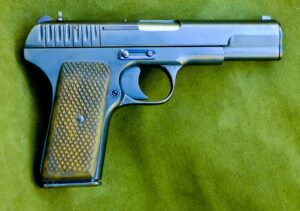
On this gun some of the parts were fire blued like on a Luger pistol and the rest of the gun was given a rust blue. This was a far finer finish than it originally had. The original grips were retained. The gun was test fired while still in the white before finishing and then completely degreased in an ultrasonic cleaner before finishing then oiled and test fired again after finishing. Eugene will not accept anything except total reliability from his work. The finished pistol now looks like one of the finely polished presentation pieces once given to foreign diplomats.
The next gun in the photos is a 1906 German Navy Luger. It had no mechanical damage, only severe rust pitting from its salt laden environment as is common to navy issue weapons. Eugene once restored a rusty navy issue WW1 98 Mauser rifle with the same problem. TIG welding and hand finishing restored it back to new. There was another part of the restoration of note done here as well.
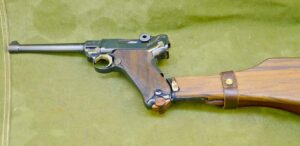
The M1906 Navy Luger was the first Luger adopted by Germany and was made in small quantities with a very low survival rate today. These were delivered in 3 separate lots of about 10,000 guns per lot with minor differences in each lot. The first lot, which included this pistol, originally had the safety configured so that the safety was on when in the up position but there were problems with it being pushed off when the pistol was holstered so the guns were altered so that the down position was the safe position. Guns of this lot were designated First Model Unaltered and First Model Altered. The alteration requires changing the grip safety as a new engagement lever had to be welded onto it.
This pistol lacked a grip safety so Eugene found an original grip safety and converted the gun back to its original First Model Unaltered configuration by welding and remarking the frame.
The Army rightly considered the grip safety a liability as it offered a place for dirt to inter the mechanism and jam the gun so the Army version, the famed P08, was made without it. They were right. In WW1 a man was killed when he drew his grip safety equipped Luger from his pocket in a trench gunfight and it did not fire because a coin was jammed in the grip safety.
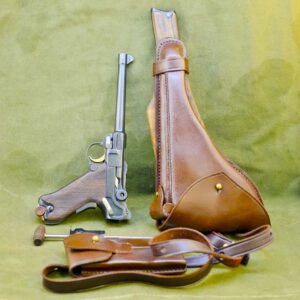
All the markings were restored to new. The navy unit markings are on the backstrap. ITD means First Torpedo Division. 1330 is the dockyard number and not a serial number. M with a crown on top designates naval issue.
An original magazine was re-nickeled and a new wood bottom added. A complete reproduction naval Luger rig was provided including a wood stock holster rig. The disk in the stock has the naval proof markings for this gun. Eugene also can provide these for artillery Lugers.
The gun was also test fired for absolute reliability. Both it and the aforementioned Tokarev have been transformed from guns that looked like junk to fine-tuned presentation showpieces that you can safely stake your life on in a gunfight. This is what a real restoration is all about. Just look at the before and after pictures and honestly tell which gun you would rather have.
Lugerman
1872 East Old Lincoln Highway
Langhorne, PA 19047
267-603-6116
Email: eugene@lugerman.com
Website: Lugerman.com You can see his videos on YouTube by searching “Lugerman Inc.”



